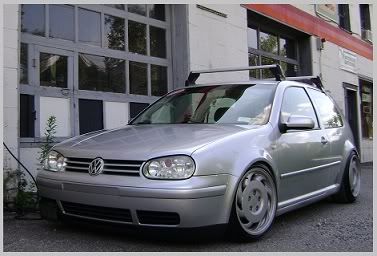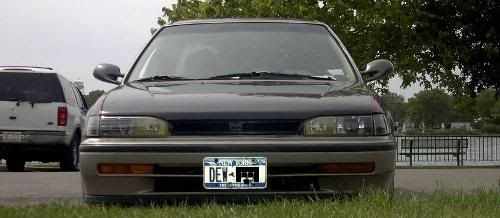So, a guy named Vince who is a tinkerer/inventer approached me several months ago about a very unique valve design that he resently patented.
He wants to put a set of these valves into my engine for testing purposes and to get some data on them. He's only used them in V8's, and other domestic engines and is curious as to how much of a performance impact they will have on an econo-box 4 banger.
Now, I'm sure most of you haven't the slightest idea as to what I'm talking about...a valve is a valve right?...wrong.
These valves that he has designed use a CNC machined floating ring around the valve to serve as a floating seat, this floating seat allows the valve to close itself when intake air tries to reverberate back into the manifold. Follow me so far?
These valves are only for the intake side of the head and pretty much allow you to have as much overlap as mechanically possible without any losses in the low end, as a matter of fact these valves cause the torque curve on the low-end of the powerband to see dramatic increases. Also, because the valve essentially closes itself when air tries to escape the combustion chamber it makes even the most wildly cammed motor idle like stock.
I've seen the prototypes for these valves and I have also seen the documentation and dyno sheets. The best example he gave me was a Jeep rock crawler, they loaded it on the dyno, and placed a load on it, in order to maintain that load without stalling the motor, it had to be held at nearly 4000rpm. They then tested the same vehicle with his intake valves installed under the same load, and the Jeep idled through the load at only 550rpm...that's astonishing in my book. Also, the torque curve was impressive and climbed nearly 50lbs. ft.over the baseline, at only 800rpm...
Now, Vince basically wants me to install these intake valves and the largest overlap cam I can find. He has guarenteed that even with something similar to the Delta 282 race cam, my car will idle even lower than stock and will come to life at 500rpm and all the way till the cam runs out of juice, no 4000-7000rpm powerbands, just constant, consistent power.
I'll be seeing him again at SEMA tomorrow to give him one of my F22a intake valves so that he can make the prototypes for me. I just wanted to tell you guys about this amazing opportunity and I wanted to get your input. I know that the idea is a bit out there, but I have seen the proof and I understand the logic behind the design. This design also works well on turbo motors, allowing greater overlap in the cam without sacrificing any power. Let me know what you guys think, and I will keep you posted. I also need to know if anyone has specs on the Delta 282, as well as personal experience with idle, powerband, piston-valve clearance, etc. I will try to get some pictures or diagrams of the valves if he'll give them to me, but I know that these are still in the prelimenary stages of design and manufacture and he is still rather hush-hush about them.
-Kyle
He wants to put a set of these valves into my engine for testing purposes and to get some data on them. He's only used them in V8's, and other domestic engines and is curious as to how much of a performance impact they will have on an econo-box 4 banger.
Now, I'm sure most of you haven't the slightest idea as to what I'm talking about...a valve is a valve right?...wrong.
These valves that he has designed use a CNC machined floating ring around the valve to serve as a floating seat, this floating seat allows the valve to close itself when intake air tries to reverberate back into the manifold. Follow me so far?
These valves are only for the intake side of the head and pretty much allow you to have as much overlap as mechanically possible without any losses in the low end, as a matter of fact these valves cause the torque curve on the low-end of the powerband to see dramatic increases. Also, because the valve essentially closes itself when air tries to escape the combustion chamber it makes even the most wildly cammed motor idle like stock.
I've seen the prototypes for these valves and I have also seen the documentation and dyno sheets. The best example he gave me was a Jeep rock crawler, they loaded it on the dyno, and placed a load on it, in order to maintain that load without stalling the motor, it had to be held at nearly 4000rpm. They then tested the same vehicle with his intake valves installed under the same load, and the Jeep idled through the load at only 550rpm...that's astonishing in my book. Also, the torque curve was impressive and climbed nearly 50lbs. ft.over the baseline, at only 800rpm...
Now, Vince basically wants me to install these intake valves and the largest overlap cam I can find. He has guarenteed that even with something similar to the Delta 282 race cam, my car will idle even lower than stock and will come to life at 500rpm and all the way till the cam runs out of juice, no 4000-7000rpm powerbands, just constant, consistent power.
I'll be seeing him again at SEMA tomorrow to give him one of my F22a intake valves so that he can make the prototypes for me. I just wanted to tell you guys about this amazing opportunity and I wanted to get your input. I know that the idea is a bit out there, but I have seen the proof and I understand the logic behind the design. This design also works well on turbo motors, allowing greater overlap in the cam without sacrificing any power. Let me know what you guys think, and I will keep you posted. I also need to know if anyone has specs on the Delta 282, as well as personal experience with idle, powerband, piston-valve clearance, etc. I will try to get some pictures or diagrams of the valves if he'll give them to me, but I know that these are still in the prelimenary stages of design and manufacture and he is still rather hush-hush about them.
-Kyle








Comment